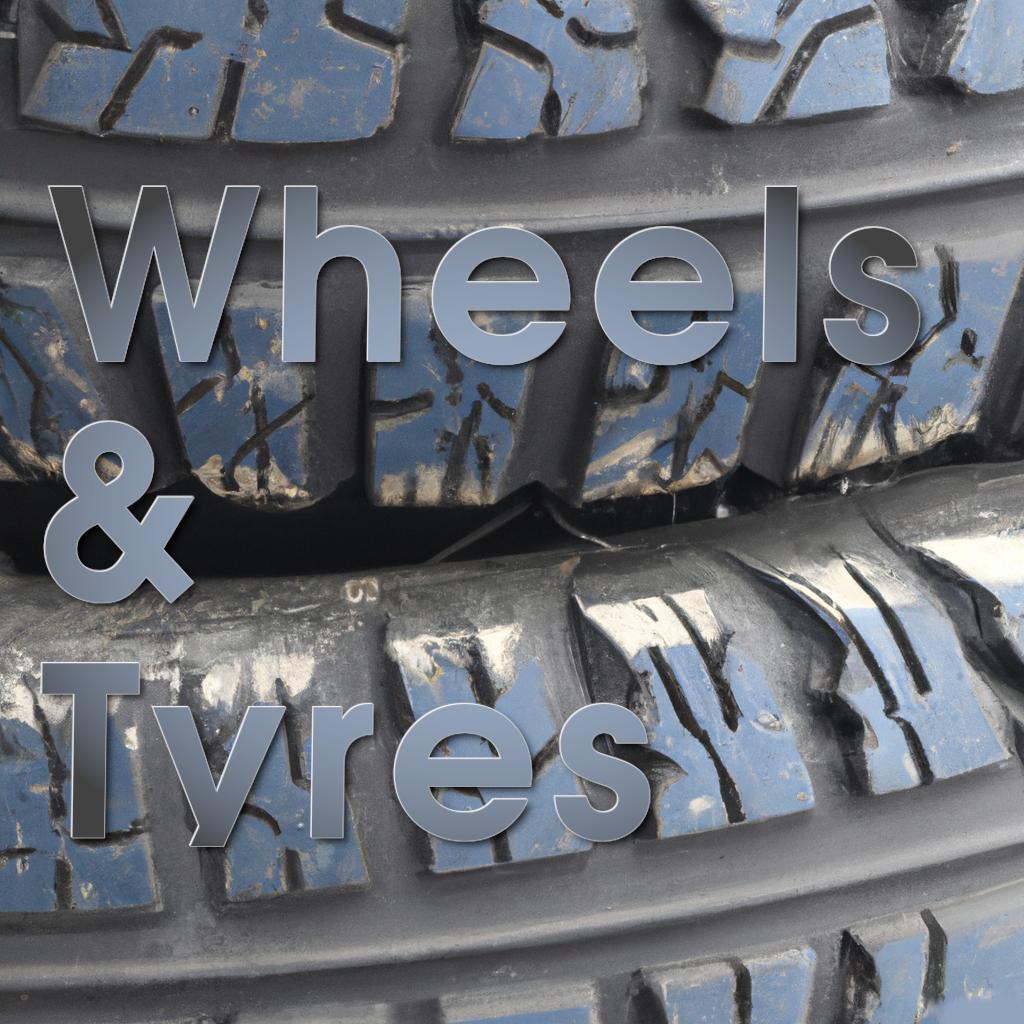


In the world of automotive care, ensuring the health and longevity of your car's wheels and tyres is paramount. From maintaining proper inflation to conducting regular inspections, the art of tyre maintenance is a crucial aspect of safe and smooth driving. Join us on a journalistic exploration as we unveil the secrets of how to keep your wheels and tyres in top condition.
The Foundation: Proper Inflation
The journey of tyre maintenance begins with one fundamental step: ensuring proper inflation. Adequate tyre pressure is essential for optimal performance, fuel efficiency, and safety on the road. Consult your vehicle's manual or the sticker located on the driver's side door jamb for the recommended tyre pressure, and check it regularly with a reliable pressure gauge. Remember to adjust tyre pressure according to load and driving conditions, such as long trips or changes in weather.
The Tread Test: Monitoring Tread Wear
Treadwear is a critical indicator of tyre health and safety. Inspect your tyres regularly for signs of wear, such as uneven tread depth or bald spots. An easy way to check tread depth is by using the penny test: insert a penny into the tread grooves with Lincoln's head facing downwards. If you can see the top of Lincoln's head, it's time to replace your tyres. Additionally, keep an eye out for any bulges, cracks, or punctures, as these can compromise tyre integrity and performance.
Rotation Routine: Even Wear Distribution
Rotating your tyres regularly is essential for promoting even wear and extending their lifespan. Tyre rotation patterns vary depending on whether your vehicle is front-wheel drive, rear-wheel drive, or all-wheel drive. Consult your vehicle's manual for the recommended rotation schedule and pattern, typically every 6,000 to 8,000 miles. By rotating your tyres, you'll ensure balanced wear and maintain consistent performance across all four wheels.
Alignment Alignment: Ensuring Proper Alignment
Wheel alignment plays a crucial role in tyre wear and vehicle handling. Misaligned wheels can cause uneven tyre wear, steering pull, and compromised vehicle stability. Schedule a wheel alignment check with a certified technician if you notice any signs of uneven tyre wear or steering instability, or if your vehicle pulls to one side. Proper wheel alignment will ensure that your tyres wear evenly and your vehicle tracks straight on the road.
Environmental Considerations: Eco-Friendly Tyre Practices
Tyre maintenance isn't just about vehicle performance; it's also about environmental responsibility. Properly inflated tyres improve fuel efficiency, reducing carbon emissions and your vehicle's environmental footprint. Additionally, consider eco-friendly tyre options, such as low-rolling-resistance tyres, which are designed to enhance fuel efficiency and reduce greenhouse gas emissions. By practising environmentally conscious tyre maintenance, you'll not only save money on fuel but also contribute to a cleaner, greener planet.
Technological Tools: Leveraging Technology for Tyre Care
In today's digital age, technology offers valuable tools for tyre maintenance. Tire pressure monitoring systems (TPMS) alert drivers to changes in tyre pressure, providing real-time information on tyre health. Consider investing in a TPMS for added peace of mind and convenience. Additionally, smartphone apps and connected car platforms offer tyre maintenance reminders, helping you stay on top of your tyre care routine.
Wheels and tires are two essential components of a vehicle's performance and safety. Here's some information about each.
Wheels:
• Wheels are the circular metal or alloy component of a car that the tire is mounted on.
• They come in various sizes and designs, which can affect a vehicle's performance, handling, and appearance.
• The size of a wheel is typically measured by its diameter, which is the distance between the two opposite points on the edge of the wheel. Common sizes include 15, 16, 17, and 18 inches.
• Some vehicles have different wheel sizes for front and rear wheels, which can affect the vehicle's handling and balance.
Tires:
• Tires are rubber components that provide traction and support for a vehicle while driving.
• They come in various sizes and types, including all-season, winter, and performance tires.
• Tires have several important ratings, including their size, speed rating, and load index.
• The size of a tire is typically measured by its width, aspect ratio, and diameter. For example, a common tire size is 225/50R17, which means the tire is 225 millimeters wide, with a 50% aspect ratio, and fits on a 17-inch wheel.
• The speed rating of a tire indicates the maximum speed it can safely handle. Common speed ratings include S (up to 112 mph), H (up to 130 mph), and V (up to 149 mph).
• The load index of a tire indicates the maximum weight it can support. Common load indexes range from 75 (load capacity of 852 pounds) to 126 (load capacity of 3,748 pounds).
It's important to maintain proper tire pressure, alignment, and balance to ensure safe and efficient driving. Regularly check your tires for signs of wear and replace them as needed to ensure optimal performance and safety.
There are several types of tires available, each designed for specific driving conditions and vehicle types. Here are some common tire types and their specifications:
All-season tires: These tires are designed for year-round use in a variety of driving conditions, including wet and dry roads. They typically have a tread pattern that provides good traction in both conditions and are often rated for snow and ice.
Summer tires: These tires are designed for use in warm weather conditions, with a tread pattern that provides good traction on dry roads. They may not perform as well on wet or icy roads, so they are not recommended for use in winter conditions.
Winter tires: These tires are designed for use in cold and snowy conditions, with a tread pattern that provides good traction on snow and ice. They are often made with special rubber compounds that remain flexible in low temperatures.
Performance tires: These tires are designed for sports cars and high-performance vehicles, with a tread pattern that provides excellent handling and grip on dry roads. They may not perform as well in wet conditions and have a shorter lifespan than other tire types.
All-terrain tires: These tires are designed for use on SUVs and light trucks, with a tread pattern that provides good traction on both on- and off-road surfaces. They may not provide the same level of comfort and handling as other tire types on paved roads.
Tire specifications typically include the tire size, speed rating, and load index. The tire size is listed as a series of numbers and letters on the sidewall of the tire, indicating the width, aspect ratio, and wheel diameter. The speed rating indicates the maximum speed the tire is rated to handle, while the load index indicates the maximum weight the tire can support.
(!) When selecting tires, it's important to consider the specific driving conditions and vehicle type to ensure optimal performance and safety.
Here are some steps you can take to check the wheels and tires on your car:
Check the tire pressure: Use a tire pressure gauge to check the pressure in each tire, and compare the reading to the recommended pressure listed in the owner's manual or on the sticker inside the driver's side door. Inflate or deflate the tires as needed.
Inspect the tread: Check the tread depth on each tire by placing a penny into the tread groove with Lincoln's head upside down. If you can see the top of Lincoln's head, the tread is worn and the tire needs to be replaced. Also, look for any signs of uneven wear or damage to the tread.
Check for cracks or bulges: Inspect the sidewalls of each tire for cracks, bulges, or other signs of damage. Any visible damage to the tire could indicate a potential safety hazard and the tire should be replaced.
Check the wheel alignment: If your car is pulling to one side or the steering wheel is not centered, it may be a sign that the wheels are misaligned. You can check the alignment visually by standing behind the car and looking at the wheels. They should be straight and parallel to each other.
Check the lug nuts: Make sure the lug nuts on each wheel are tight and properly torqued. Loose lug nuts can cause the wheel to wobble or even come off while driving.
If you notice any issues with the wheels or tires, it's important to have them inspected and repaired by a professional mechanic. Regular maintenance and inspections can help ensure your car is safe and running smoothly.
Tyre maintenance is a crucial aspect of vehicle ownership that directly impacts safety, performance, and environmental sustainability. By following these key steps – maintaining proper inflation, monitoring tread wear, rotating tyres regularly, ensuring proper alignment, considering environmental factors, and leveraging technological tools – you'll keep your wheels and tyres in optimal condition for miles to come.
Sincerely yours,

We use cookies
We use cookies and other tracking technologies to improve your browsing experience on our website, to show you personalized content and targeted ads, to analyze our website traffic, and to understand where our visitors are coming from. Privacy Policy.